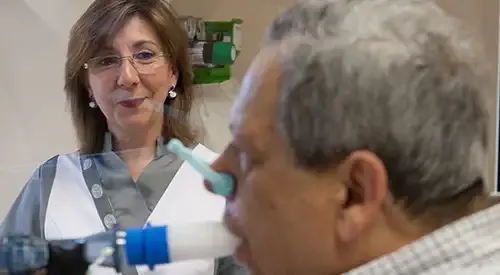Chronic obstructive pulmonary disease
"The Clinic has launched a Program for Comprehensive Care of COPD with the aim of early diagnosis of this disease to administer the most appropriate treatment".
DR. ANA BELÉN ALCAIDE
SPECIALIST. PNEUMOLOGY DEPARTMENT

Chronic obstructive pulmonary disease (COPD) includes under its name pathologies such as pulmonary emphysema, chronic bronchitis and long term asthma involvement in people who have actively or passively smoked.
COPD is a disease characterized by a non-reversible obstruction of the bronchi that, in the most severe cases, can be associated with a destruction of the lung. In addition, these patients may present with cough, phlegm, wheezing and shortness of breath.
Emphysema, a variant of COPD, is a common respiratory pathology, without curative treatment, that affects the small airways or alveoli. It limits exhalation and is accompanied by coughing and shortness of breath.
The Pneumology Department has been accredited as a Basic COPD Unit with excellence by the Spanish Society of Pneumology and Thoracic Surgery (SEPAR).

What are the symptoms of COPD?
The most common symptoms of COPD are
- Usual cough and expectoration.
- Repeated respiratory infections.
- Presence of shortness of breath (dyspnea) with effort.
- Sometimes there may be wheezing in the chest.
However, in early stages, COPD may not have symptoms, so there are thousands of patients who do not know they are affected (3 out of 4 cases).
This is because the onset of symptoms tends to be slow, and a chronic cough or mild shortness of breath is usually accepted as a normal part of aging or an expected consequence of smoking.
Do you have any of these symptoms?
You may have chronic obstructive pulmonary disease
What causes COPD?
Some of the causes of chronic obstructive pulmonary disease are mainly tobacco use, smoke inhalation, charcoal, exposure to dust and toxic products.
Along with these, there are genetic factors such as alpha-1-antitrypsin deficiency or age. Since it develops over time, it is more common from the age of 40.
Who can get COPD?
COPD is very common, suffered by approximately 9% of the Spanish population between 40 and 69 years, and more seriously, increasing.
In the early 1990s it was the sixth leading cause of death in the general population, but forecasts for 2020 place it in third place.
The increase in smoking among women and young people is the cause of these forecasts.
How is COPD diagnosed?

The main diagnostic procedure to determine the existence of COPD is spirometry, a simple test that should be performed on all smoking patients over 40 years of age who have been smoking for some time, especially if they have respiratory symptoms.
Other candidates for testing to rule out COPD are patients with a history of exposure to biomass degradation products -wood or coal smoke, among others-, as well as those with occupational risk -hospitality workers or those exposed to inhaled toxicants.
Within the Program for Integrated Care of COPD, the tests performed on patients begin with spirometry in which lung volumes are assessed, CO diffusion by means of complete respiratory function tests and a gasometry.
The initial assessment protocol includes the performance of a low-dose radiation chest CT, a test included in the screening program for early detection of lung cancer. A blood test will also be performed to assess blood counts and kidney and liver function, among other factors.
A nutritional evaluation of the patient will also be carried out, as well as a study of other diseases that usually appear associated with COPD: cardiovascular pathologies, lung cancer, diabetes, anxiety, depression, osteoporosis and ophthalmological problems, circumstances in which the patient would be referred to the corresponding specialist. In addition, the patient is asked to fill out several questionnaires: on quality of life and on anxiety and depression, to obtain the maximum information and achieve an accurate evaluation of the patient.
How is chronic obstructive pulmonary disease treated?
Within the medical treatment itself, respiratory physiotherapy and rehabilitation programs have an increasingly prominent role, conditioning remarkable improvements in physical capacity and quality of life.
Pharmacological treatment
From the pharmacological point of view, inhaled bronchodilators, theophyllines and, in certain cases, corticoids, both inhaled and oral or parenteral, are the most widely used treatments.
Good compliance and an appropriate inhalation technique (there are different modalities to facilitate the use of these drugs) are crucial for their proper administration.
In case of respiratory failure, home oxygen administration is indicated. It should be applied at least 16 hours a day, always including sleep. A lower number of hours has not been demonstrated to be effective. Oxygen is not a treatment for choking or fatigue, but it does prolong survival. In some cases, portable oxygen is also applied, through backpacks weighing a few kilos, which allow the patient to move around without giving up his or her treatment.
In recent years, some surgical techniques have come to improve the expectations of COPD patients: volume reduction surgery, applied in some cases of pulmonary emphysema with certain specific characteristics; and lung transplantation, indicated in certain patients with very advanced disease.
What clinical trials do we have on Chronic Obstructive Pulmonary Disease?
Where do we treat it?
IN NAVARRE AND MADRID
The Department of Pneumology
of the Clínica Universidad de Navarra
Specializing in smoking and tobacco-related diseases, the Department has over 15 years of experience in smoking cessation and lung cancer early detection programs.
The department's specialists have received training at leading centers around the world, including centers in the United States, and have extensive experience in the diagnosis and treatment of all respiratory diseases, both common and rare.
Diseases we treat
|

Why at the Clínica?
- Leading clinical assistance with great work in research and teaching.
- Specialized nursing team.
- We work together with the Sleep Unit and the Lung Cancer Area.








